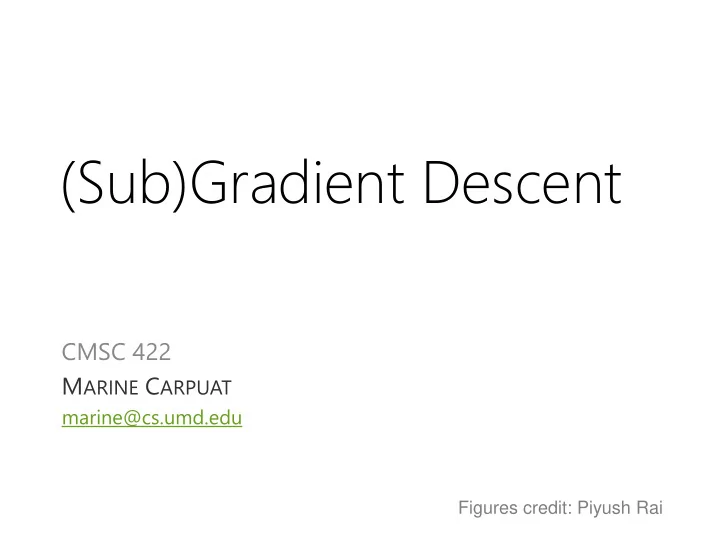

(Sub)Gradient Descent CMSC 422 M ARINE C ARPUAT marine@cs.umd.edu Figures credit: Piyush Rai
Logistics • Midterm is on Thursday 3/24 – during class time – closed book/internet/etc, one page of notes. – will include short questions (similar to quizzes) and 2 problems that require applying what you've learned to new settings – topics: everything up to this week, including linear models, gradient descent, homeworks and project 1 • Next HW due on Tuesday 3/22 by 1:30pm • Office hours Tuesday 3/22 after class • Please take survey before end of break!
What you should know (1) Decision Trees • What is a decision tree, and how to induce it from data Fundamental Machine Learning Concepts • Difference between memorization and generalization • What inductive bias is, and what is its role in learning • What underfitting and overfitting means • How to take a task and cast it as a learning problem • Why you should never ever touch your test data!!
What you should know (2) • New Algorithms – K-NN classification – K-means clustering • Fundamental ML concepts – How to draw decision boundaries – What decision boundaries tells us about the underlying classifiers – The difference between supervised and unsupervised learning
What you should know (3) • The perceptron model/algorithm – What is it? How is it trained? Pros and cons? What guarantees does it offer? – Why we need to improve it using voting or averaging, and the pros and cons of each solution • Fundamental Machine Learning Concepts – Difference between online vs. batch learning – What is error-driven learning
What you should know (4) • Be aware of practical issues when applying ML techniques to new problems • How to select an appropriate evaluation metric for imbalanced learning problems • How to learn from imbalanced data using α - weighted binary classification, and what the error guarantees are
What you should know (5) • What are reductions and why they are useful • Implement, analyze and prove error bounds of algorithms for – Weighted binary classification – Multiclass classification (OVA, AVA, tree) • Understand algorithms for – Stacking for collective classification – 𝜕 − ranking
What you should know (6) • Linear models: – An optimization view of machine learning – Pros and cons of various loss functions – Pros and cons of various regularizers • (Gradient Descent)
T oday’s topic How to optimize linear model objectives using gradient descent (and subgradient descent) [CIML Chapter 6]
Casting Linear Classification as an Optimization Problem Loss function Regularizer measures how well prefers solutions Objective classifier fits training that generalize function data well Indicator function: 1 if (.) is true, 0 otherwise The loss function above is called the 0-1 loss
Gradient descent • A general solution for our optimization problem • Idea: take iterative steps to update parameters in the direction of the gradient
Gradient descent algorithm Objective function Number of steps Step size to minimize
Illustrating gradient descent in 1-dimensional case
Gradient Descent • 2 questions – When to stop? – How to choose the step size?
Gradient Descent • 2 questions – When to stop? • When the gradient gets close to zero • When the objective stops changing much • When the parameters stop changing much • Early • When performance on held-out dev set plateaus – How to choose the step size? • Start with large steps, then take smaller steps
Now let’s calculate gradients for multivariate objectives • Consider the following learning objective • What do we need to do to run gradient descent?
(1) Derivative with respect to b
(2) Gradient with respect to w
Subgradients • Problem: some objective functions are not differentiable everywhere – Hinge loss, l1 norm • Solution: subgradient optimization – Let’s ignore the problem, and just try to apply gradient descent anyway!! – w e will just differentiate by parts…
Example: subgradient of hinge loss
Subgradient Descent for Hinge Loss
Summary • Gradient descent – A generic algorithm to minimize objective functions – Works well as long as functions are well behaved (ie convex) – Subgradient descent can be used at points where derivative is not defined – Choice of step size is important • Optional: can we do better? – For some objectives, we can find closed form solutions (see CIML 6.6)
Recommend
More recommend